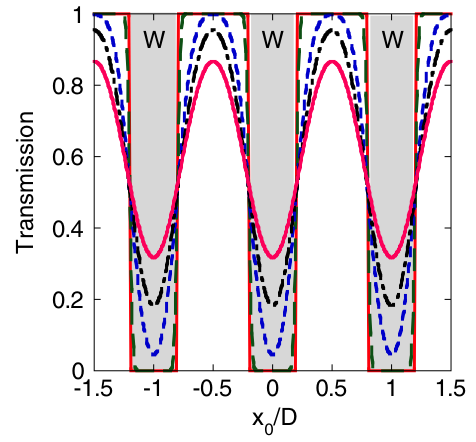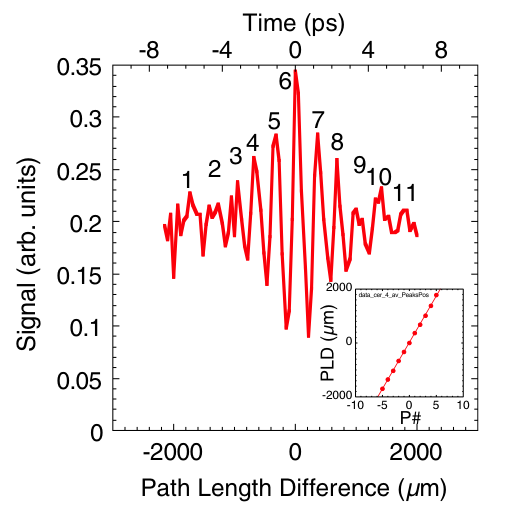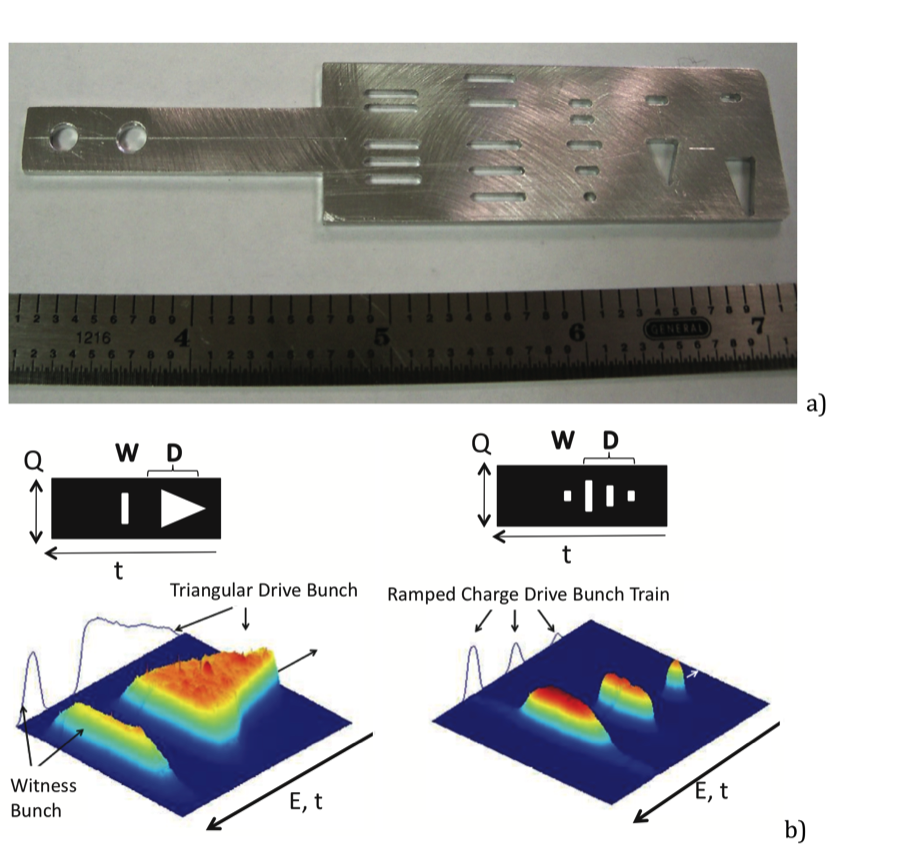- Home
- Capabilities
- Science Highlights
- Operations
- Publications
-
ES&H
- Experiment Start-up
- Laser Safety
Collider-Accelerator Dept.
- C-AD ES&H Resources
- Staff
- Users' Place
- Apply for Access
Masking Techniques and Micro-bunch Train Production
Generation of micro-bunch trains with variable period opens an important area of applications, such as the resonant excitation of wakefields. An ATF user experiment demonstrated a stable train of micro-bunches with a controllable sub-picosecond delay [1, 2]. The train was produced by imprinting the shadow of a periodic mask on to a several-picosecond bunch with a correlated energy spread (see Figure 1).

Figure 1. (a) Principle schematic of the mask technique; only the dogleg section of the beam line and two quadrupoles are pictured. (b) Train of bunches measured in the energy plane, configured for application in the PWFA experiment: five equidistant drive bunches followed by a witness bunch, with a separation one-and-a-half times that of the drive bunches. This picture was taken from the beam profile monitor located immediately downstream of the mask.
The mask is placed in the region of a beam line where the beam’s transverse size is dominated by the correlated energy spread. The mask disrupts the emittance of particles that strike the material; these particles are subsequently lost along the beam-transport line. When entering the dispersion-free region of the beam line, the energy modulation of the transmitted electrons is converted into a corresponding bunch structure in the time domain. Transmitted fraction T of the charge as a function of the beam centroid position x0 is given by the convolution of the beam betatron size and the mask shape [3]:
 (1)
(1)
where xw,i is the position of the ith wire for a mask with equidistant wires xw,i = iD, i = ..., -1, 0, +1, ... . The transmission for a mask with d/D ˜ 0.4, similar to the ratio in the experiment, is plotted in Fig. 2 for various sxß /(d/2). Figure 2 shows that for sxß /(d/2)= 0.01 the shadow closely follows the mask shape and the bunches are well formed. For sxß /(d/2)= 0.1 the gap between the bunches starts filling up, while for sxß /(d/2) = 0.5 the bunch train charge distribution becomes continuous.

Figure 2. Plot of the beam transmission through the mask (as described by Eq.1 ) with normalized parameters d/D ˜0.4 as function of the position (corresponding to energy in a dispersive region) of the beam for various ratios of betatron transverse size sß to mask wire diameter sß /(d/2)= 0.01 (red line); 0.1 (green line); 0.5 (blue line); 0.75 (black line, similar to parameters in [1]), and 1.0 (pink line). The wires are indicated by shaded regions and the letter W.
Interferometric measurements of coherent transition radiation (CTR) confirm the occurrence of the micro-bunch train with less than 1 ps spacing between bunches (Figure 3) . This method can be implemented in any particle accelerator that includes a magnetic chicane or dog-leg arrangement. It also can be used in conjunction with magnetic compression to produce trains of even shorter electron micro-bunches. At the ATF, this method is extensively used in PWFA user experiments.

Figure 3. CTR interferometer trace for the mask with d = 500 µm and D = 1.27 mm. The distance between the peaks is determined from a linear fit of the measured path length difference (PLD) versus peak number (P#) shown in the inset for the 11 peaks (six bunches). The slope of the curve and therefore the distance between bunches is about 344 µm.
Later, the electron bunch masking technique at ATF was developed with more complicated mask profiles to produce shaped bunches , see Figure 4.

Figure 4. Picture of the mask used to produce the tailored bunches (top). The material is aluminum, and the thickness approximately 2 mm. The two left-most patterns produce trains with no charge tailoring, while the three right-most patterns produce the ramped bunch train (bottom right) and two triangular bunch patterns followed by a witness bunch (bottom left) [4]
[1] Muggli, P., et al., Simple method for generating adjustable trains of picosecond electron bunches. Physical Review Special Topics-Accelerators and Beams, 2010. 13(5): p. 052803.
[2] Muggli, P., et al., Generation of trains of electron microbunches with adjustable subpicosecond spacing. Phys Rev Lett, 2008. 101(5)
[3] Muggli, P. et al., in Proceedings AAC08, AIP Conf. Proc No. 1086 (AIP, New York, 2008), p. 683
[4] Muggli, P. et al., Excitation of plasma wakefields with designed bunch trains. IPAC2012, WEPPP051, New Orleans, Louisiana, 2012




